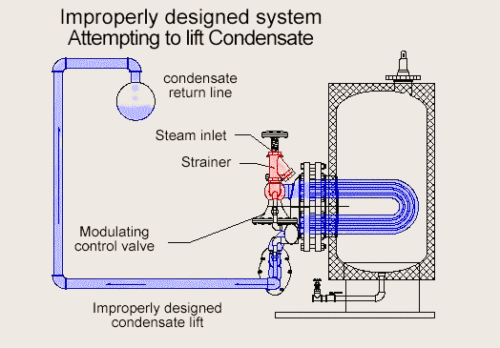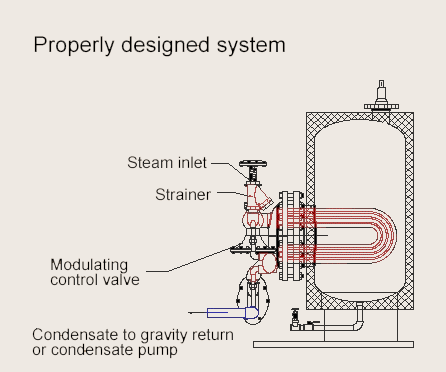When using a steam modulating control valve with a water heater or unfired steam generator, it is most important to discharge the condensate from the float and thermostatic trap to gravity drain and do not to attempt to lift the condensate above the outlet of the float and thermostatic trap without the use of a properly installed condensate pump. When piping the condensate to a condensate pump there should be no backpressure in the condensate line. Therefore, the condensate outlet should be piped to a vented receiver before going to the condensate pump. Attempting to lift condensate using the steam pressure going to the modulating control valve or back pressure in the condensate line leads to poor temperature or pressure control, reduction in capacity, corrosion and premature failure of the tubes, control valve, and trap, and water hammer in the tube bundle. Any improper condensate lifts will result in the return piping filled with condensate. If the lift is higher than the submerged coil, the coil will flood with condensate whenever the modulating control valves closes. In a water heater this will result in temperature overshoot, as the hot condensate will transfer heat through the coil and over heat the water. In an unfired steam generator, condensate in the coil can result in decreased capacity of the unit.
It is necessary for the designer/installer to make provisions to drain the condensate by gravity or into either an electric or pressure powered condensate pump. All CEMLINE® heaters and unfired steam generators are furnished with a steam pressure modulating control valve and as the valve closes, the steam pressure in the coil is reduced to zero psig.
As an example, a heater designed to operate on 15 psig steam is installed in an improperly designed system with 10 feet of condensate lift. A 10-foot column of water will have a pressure of 4.5 psig based on the knowledge that water can be raised 2.2 feet for each pound of pressure applied at the bottom of a column of water. The minimum pressure drop across the valve will typically be 30%. Meaning the maximum pressure in the coil head will be 10.5 psig. The steam condensing in the coil will further reduce the pressure in the coil to a pressure less than the 4.5 psig required to lift the condensate. The heater will stall until no more steam can enter because the backpressure from the 10-ft head of the condensate is greater than the available pressure in the coil. The valve, sensing the temperature in the heater is dropping, opens wider which allows more pressure into the coil and overcomes the 4.5 psig and lifts some of the condensate. This influx of steam will bring the heater to the set point and as the control valve closes, the pressure in the coil goes to zero psig. As soon as the pressure drops below 4.5 psig, no more condensate is removed from the coil and the 10-ft head of condensate will then back feed through the trap and flood the coil with 250 degree F condensate. The coil transfers the heat from the 250 degree condensate to the domestic water, resulting in an over temperature condition in the heater.
It is the responsibility of the designer/installer to properly gravity drain the condensate or provide a condensate pump to lift the condensate. CEMLINE CORPORATION® is represented by trained, expert sales agents in steam systems. Please contact the factory or one of our sales agents for assistance.
Remember, do not attempt to lift the condensate from a water heater or unfired steam generator without the assistance of a properly installed and vented condensate pump.

